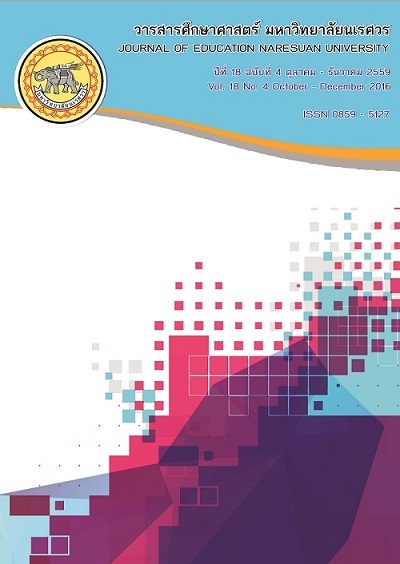การพัฒนาหลักสูตรเยาวชนรู้เท่าทันสื่อตามแนวคิดการเรียนรู้ แบบมีส่วนร่วม สำหรับนักเรียนชั้นมัธยมศึกษาตอนต้น
Main Article Content
Abstract
การวิจัยครั้งนี้มีวัตถุประสงค์เพื่อพัฒนาหลักสูตรเยาวชนรู้เท่าทันสื่อตามแนวคิดการเรียนรู้แบบมีส่วนร่วม สำหรับนักเรียนชั้นมัธยมศึกษาตอนต้น มีขั้นตอนการดำเนินการตามกระบวนการวิจัยและพัฒนาหลักสูตร 4 ขั้นตอน ดังนี้ ขั้นตอนที่ 1 ศึกษาข้อมูลพื้นฐานแบ่งออกเป็น 3 ส่วน ดังนี้ 1) ศึกษาความคิดเห็นของผู้ทรงคุณวุฒิเกี่ยวกับการเสริมสร้างการรู้เท่าทันสื่อ 2) สัมภาษณ์ผู้ทรงคุณวุฒิเกี่ยวกับคุณลักษณะการรู้เท่าทันสื่อและแนวทางการพัฒนาหลักสูตร 3) ศึกษาการรู้เท่าทันสื่อของนักเรียน ผลสรุปจากการสอบถามความคิดเห็นของผู้ทรงคุณวุฒิ มีความคิดเห็นเกี่ยวกับการเสริมสร้างการรู้เท่าทันสื่ออยู่ในระดับมาก จากการสัมภาษณ์ผู้ทรงคุณวุฒิเกี่ยวกับคุณลักษณะการรู้เท่าทันสื่อและแนวทางการพัฒนาหลักสูตร ผู้ทรงคุณวุฒิต้องการให้จัดทำหลักสูตรเพื่อเสริมสร้างการรู้เท่าทันสื่อ ผู้วิจัยสรุปองค์ประกอบพฤติกรรมการรู้เท่าทันสื่อได้ 5 องค์ประกอบ ได้แก่ 1) การเข้าถึงสื่อหรือการรับสื่อ 2) การวิเคราะห์สื่อ 3) การเข้าใจสื่อ 4) การประเมินค่าสื่อ และ 5) การใช้สื่อให้เกิดประโยชน์ และผลการสอบถามการรู้เท่าทันสื่อของนักเรียนพบว่านักเรียนมีระดับการรู้เท่าทันสื่ออยู่ในระดับปานกลาง จึงนำข้อมูลที่ได้สร้างหลักสูตรเยาวชนรู้เท่าทันสื่อตามแนวคิดการเรียนรู้แบบมีส่วนร่วม ขั้นตอนที่ 2 การสร้างและตรวจสอบคุณภาพของหลักสูตร แบ่งออกเป็น 3 ส่วนดังนี้ 1) พัฒนาหลักสูตรฉบับร่างเป็นการสร้างหลักสูตรเสริมให้สอดคล้องกับผลการศึกษาข้อมูลพื้นฐานในขั้นตอนที่ 1 มี 10 องค์ประกอบ ได้แก่
1.1) สภาพปัญหาและความต้องการของหลักสูตร 1.2) หลักการ 1.3) จุดมุ่งหมาย 1.4) โครงสร้าง 1.5) คำอธิบายรายวิชา 1.6) สาระการเรียนรู้ 1.7) คำอธิบายหน่วยการเรียนรู้ 1.8) แนวการจัดกิจกรรมการเรียนรู้ 1.9) แนวการใช้สื่อและแหล่งเรียนรู้ และ 1.10) แนวการวัดและประเมินผล 2) ตรวจสอบและปรับปรุงแก้ไขหลักสูตร จากการประเมินความเหมาะสมและความสอดคล้องของหลักสูตรฉบับร่างโดยผู้เชี่ยวชาญ พบว่า หลักสูตรมีความเหมาะสมและสอดคล้องทุกองค์ประกอบ และนำข้อเสนอแนะของผู้เชี่ยวชาญมาปรับปรุงแก้ไข หลักสูตรที่พัฒนาขึ้นเป็นหลักสูตรที่เน้นกระบวนการโดยจัดกิจกรรมการเรียนรู้ตามแนวคิดการเรียนรู้แบบมีส่วนร่วม ดังนี้ 2.1) ขั้นนำ เรียน เร้า เข้าใจสื่อ
2.2) ขั้น วิเคราะห์ ตีความ ตามสื่อ 2.3) ขั้นประเมินค่า ตรวจหาคุณภาพสื่อ และ 2.4) ขั้นประยุกต์ใช้ ใส่ใจป้องกันสื่อ 3) การตรวจสอบคุณภาพของหลักสูตร โดยหาค่าดัชนีประสิทธิผลของหลักสูตร พบว่า หลักสูตรมีค่าดัชนีประสิทธิผล 0.6759 เป็นไปตามเกณฑ์ แสดงให้เห็นว่า หลักสูตรสามารถเสริมสร้างการรู้เท่าทันสื่อให้แก่นักเรียนได้ ขั้นตอนที่ 3 การทดลองใช้หลักสูตรกับนักเรียนชั้นมัธยมศึกษาตอนต้น ในภาคเรียนที่ 2 ปีการศึกษา 2557 จำนวน 30 คน ที่สมัครใจเรียนกิจกรรมรู้เท่าทันสื่อ ใช้แบบแผนการทดลองแบบกลุ่มเดียวทดสอบก่อนเรียน-หลังเรียน จากการทดลอง พบว่า 1) ค่าเฉลี่ยคะแนนจากการทดสอบการรู้เท่าทันสื่อหลังทดลองสูงกว่าก่อนทดลองอย่างมีนัยสำคัญทางสถิติที่ระดับ .05 2) ค่าเฉลี่ยจากแบบสอบถามความตระหนักในการรู้เท่าทันสื่อหลังทดลองมีค่าสูงกว่าก่อนทดลองอย่างมีนัยสำคัญทางสถิติที่ระดับ .05 และ 3) ค่าเฉลี่ยจากแบบประเมินพฤติกรรมการรู้เท่าทันสื่อหลังทดลองสูงกว่าก่อนทดลองอย่างมีนัยสำคัญทางสถิติที่ระดับ .05 ขั้นตอนที่ 4 การประเมินผลหลักสูตร เป็นการตรวจสอบและประเมินผลหลักสูตร แบ่งออกเป็น 2 ส่วน คือ 1) การสังเกตพฤติกรรมการรู้เท่าทันสื่อของนักเรียนหลังการทดลองใช้ 2 สัปดาห์ และ
2) การประเมินความคิดเห็นของนักเรียนที่มีต่อหลักสูตรหลังการทดลองใช้หลักสูตร พบว่า นักเรียนมีพฤติกรรมการรู้เท่าทันสื่อโดยภาพรวมอยู่ในระดับดี และนักเรียนมีความคิดเห็นต่อหลักสูตรหลังการทดลองใช้หลักสูตรโดยภาพรวมอยู่ในระดับมากที่สุด
DEVELOPMENT OF A YOUTH MEDIA LITERACY CURRICULUM BASED ON PARTICIPATION LEARNING FOR JUNIOR SECONDARY SCHOOL STUDENTS
The purpose of this research was to develop a Youth Media Literacy curriculum based on Participation Learning for lower secondary school students. This study was conducted through research and development methodology using four steps in the curriculum development process as follows; Step 1: the study of basic information needs for media literacy of the students to design the curriculum components, which was divided into three parts: 1) study the opinions of experts on enhancing media literacy, 2) interview of experts about the characteristics of media literacy and guidelines for curriculum development, and 3) study of the media literacy of students The data were derived for deriving guidelines for curriculum development. The conclusion is based on the concept of media literacy components published consisting of five components: 1) access to the media or reception of the media, 2) media analysis, 3) understanding the media, 4) media evaluation, and 5) the beneficial use of the media. Because the overall level of media literacy of the students was moderate, we created a youth media literacy curriculum based on participation learning. Step 2: Create and monitor the quality of the curriculum divided into three parts: 1) Create a draft curriculum from basic information with ten elements: 1.1) the problems and needs of the curriculum, 1.2) principles, 1.3) aims, 1.4) the structure, 1.5) description, 1.6) learning, 1.7) description of the units, 1.8) guidelines for the learning activities, 1.9) guidelines for the use of materials and resources, and 1.10) guidelines for the measurement and evaluation. 2) Determine the appropriateness and consistency of the draft curriculum by specialists. They found the curriculum is appropriate and consistent and focuses on the process by organizing learning activities based on participation learning by following four steps: 2.1) introduction to understand the media, 2.2) the interpretation by the media, 2.3) the evaluation to checking for quality media, and 2.4) applying media attention protection. 3) Pilot trial to determine the effectiveness of the curriculum, where we found that the curriculum meets productive the criteria 0.6759. This shows that the curriculum can enhance the media literacy of students. Step 3: The implementation of the curriculum used with 30 students in the second semester of academic year 2014, who volunteered to learn in a media literacy activities group, led to the following results: 1) The average rate of tests media literacy after learned was higher than before the experiment at the statistical significance level of .05. 2) The average of awareness rate of questionnaire media literacy after learned was higher than before the experiment at the statistical significance level of .05. 3) The average of behavior rate of questionnaire media literacy after learned was higher than before the experiment at the statistical significance level of .05. Step 4: The evaluation of the curriculum was divided into two parts: 1) the observation of the media literacy behavior of the students revealed that the students had a behavior of media literacy at a good level, and 2) the students' opinion 'regarding the curriculum after learning with the curriculum as a whole was at a very high level.
Article Details
The owner of the article does not copy or violate any of its copyright. If any copyright infringement occurs or prosecution, in any case, the Editorial Board is not involved in all the rights to the owner of the article to be performed.

